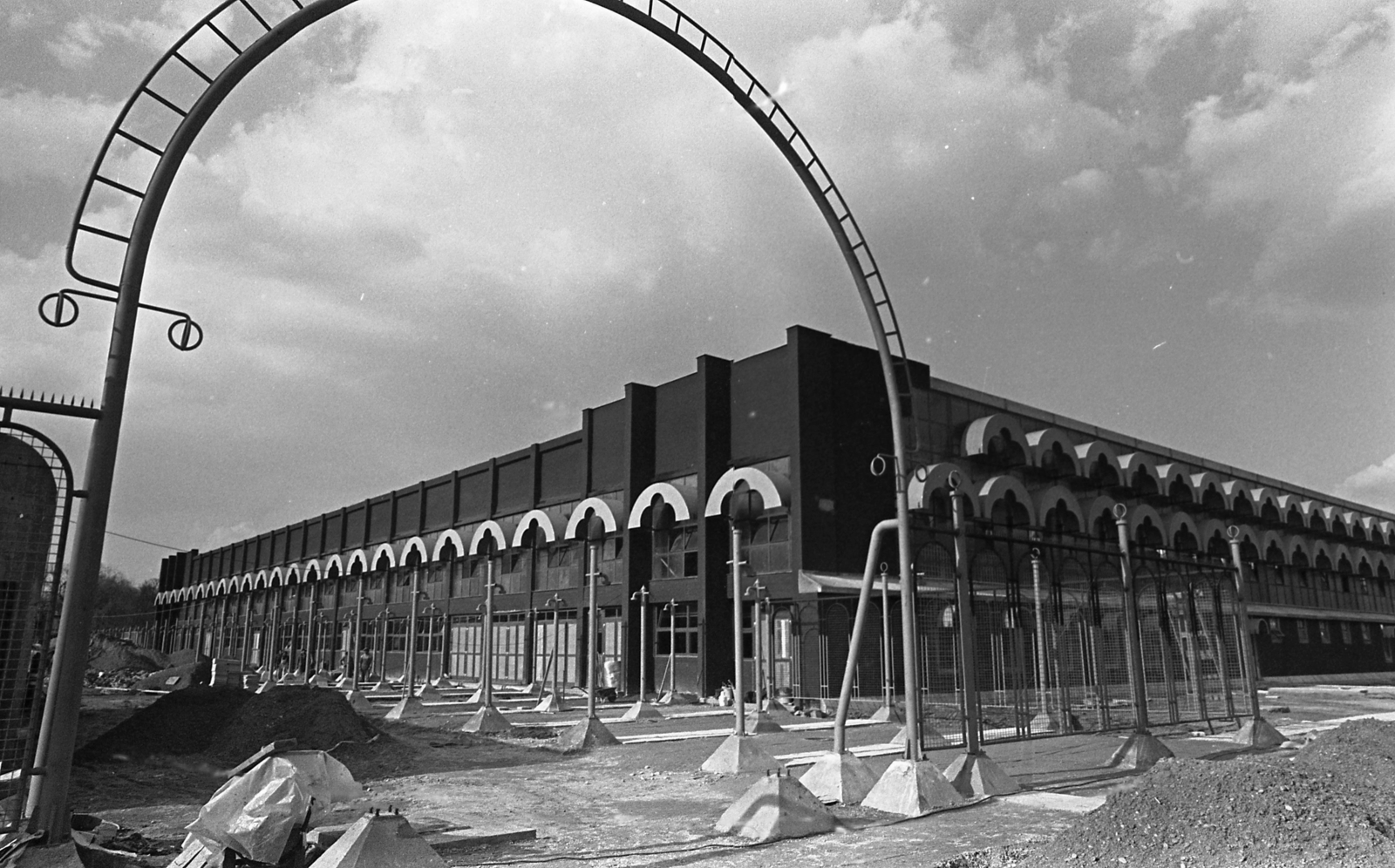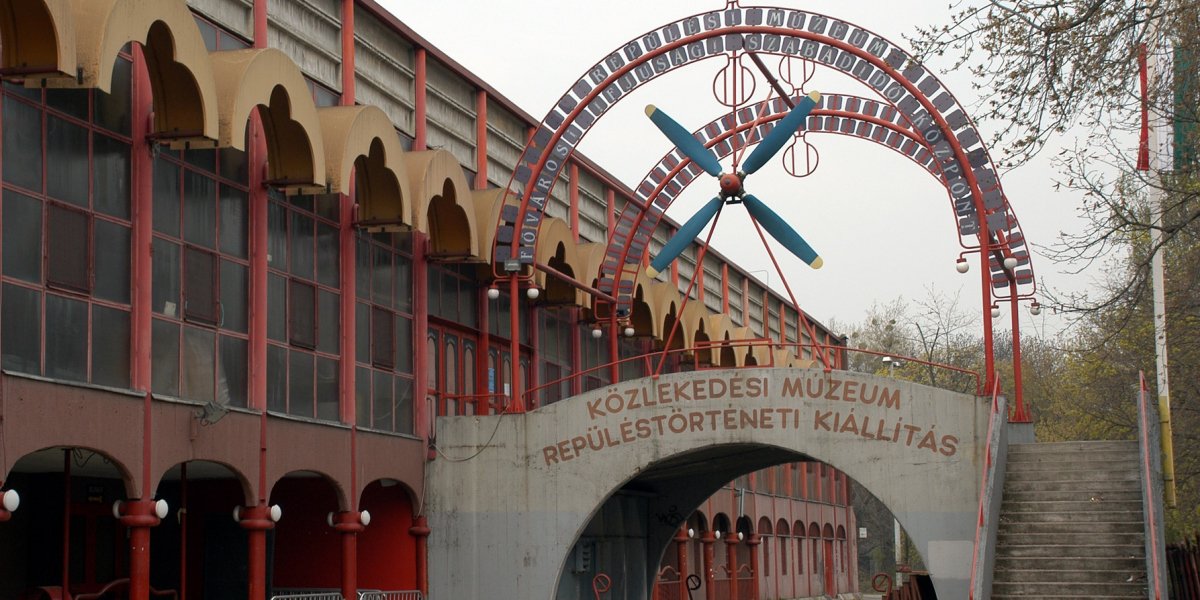Petőfi Csarnok (PECSA) was built on the ruins of the Iparcsarnok ('industrial hall'), which had been built in 1885. Throughout its history, Iparcsarnok served as a museum, an exhibition space, and even a munitions depot. Destroyed in the Second World War an exhibition hall for the Budapest International Fair (BNV) was built on its ruins. When the BNV was moved to Kőbánya, the building was converted into a warehouse.
However, 1980s decision-makers wanted to give the building a new function. Original plans slated it to be given to the Transport Museum, which was struggling with a serious lack of space. However, when Budai Ijfúsági Park, the Buda Youth Park was declared life-threatening plans had to be changed. A large part of the building was converted into what became known as Petőfi Csarnok, a major concert venue. The upper floor and the northern side halls were given to the Transport Museum.
 The Petőfi Csarnok shortly before being opened in 1985 (Photo: Fortepan/No.: 25781)
The Petőfi Csarnok shortly before being opened in 1985 (Photo: Fortepan/No.: 25781)
The museum quickly moved its rich aerospace collection into the new building, only a part of which had been on display in the overcrowded old building. On 27 November 1985 Ország-Világ wrote:
"The Transport Museum has received over 3900 square metres of exhibition space in the enormous hall, the large part of which houses the Youth Leisure Centre. The first Hungarian museum of aviation has thus been opened with a rich collection on display! It would be a shame to hide these valuable exhibits on shelves, in warehouses and hangers. Flight enthusiasts will find many interesting items on display, as will the general audience. It is also already quite clear that children, so receptive to the innovation of transportation and flight, will be among the main patrons of the new exhibit."
The exhibition was opened on 22 October 1985 but only for a short time. There had not been enough money for the complete reconstruction on the building, and thus a few "non-vital" elements had been neglected. As a result, there was no heating in the exhibition halls, and the walls were thin and windows glazed with a single plane of glass. In the winter, the hall was so cold that no one could work or comfortably visit.
The exhibition was only open from May to October. However, if it was hot outside, the building turned into a sauna, as not only was air conditioning not available, there were barely any windows that could be opened. Regardless, the exhibition did not close, despite the inside temperature reaching 40 degrees Celsius at times.
Aeroplanes on display (Photo: Hungarian Museum of Science, Technology and Transport)
As a result, the article quoted above mentioned a few critical points:
"Despite recommending that readers visit the exhibition, it should be noted that by the time these lines have been printed, the unheated halls of the exhibition will have been closed for their winter slumber. Nevertheless, we are pleased to showcase this new attraction of Budapest. We know where we will be heading on our first spring walk in City Park..."
The Junker F13 used by King Charles IV (Photo: Hungarian Museum of Science, Technology and Transport)
Sadly, these conditions remained unchanged for the 30 years the exhibition existed, despite the fact that the museum housed several treasures. One of these was the Junker F-13 used by King Charles IV in his attempt to return to the Hungarian throne. Following his unsuccessful attempted coup, the plane was seized. However, as the Treaty of Trianon, which had ended World War I, forbade flying military aircraft in Hungary, the modern machine could only be preserved for a museum.
The veteran of the First World War became a part of the collection in 191 (Photo: Hungarian Museum of Science, Technology and Transport)
Interestingly, the reconnaissance plane manufactured by Lloyd in Aszód was once displayed almost in the same place in 1917. At the time an exhibition of military aircraft was held in the Iparcsarnok. A veteran of the war, the plane was donated to the museum after the exhibition.
The 60-horsepower Lampich L-2 Róma aeroplane held several world records in the 1920s (Photo: Hungarian Museum of Science, Technology and Transport)
Beyond these motorised aircraft, several gliders manufactured in Hungary were also on display. The crew cabin used by Bertalan Farkas and Valeri Kubasov on their return from the Salyut-6 space station was also displayed in the hall for years.
Even the first Hungarian sailboat to circumnavigate the globe, the Saint Jupát, was on display here. Nándor Fa and József Gál sailed around the world between 1985 and 1987 in the Bartók spent-class yacht. The crew cabin a sailing boat were later moved to the glass tower that connects the two buildings of the Transport Museum.
In addition to these, several models, instruments and engines showcased the history of flight and space travel. When the Petőfi Csarnok was closed, the exhibition was also moved. Eventually, the hall itself was torn down as part of the Liget Project. Sadly, the vast majority of the collection is now stuck in storage as professionals work to find a solution to create a new aviation exhibition.
Cover photo: Former entrance to the Permanent Aerospace Exhibition (Photo: Hungarian Museum of Science, Technology and Transport)





































Hozzászólások
Log in or register to comment!
Login Registration